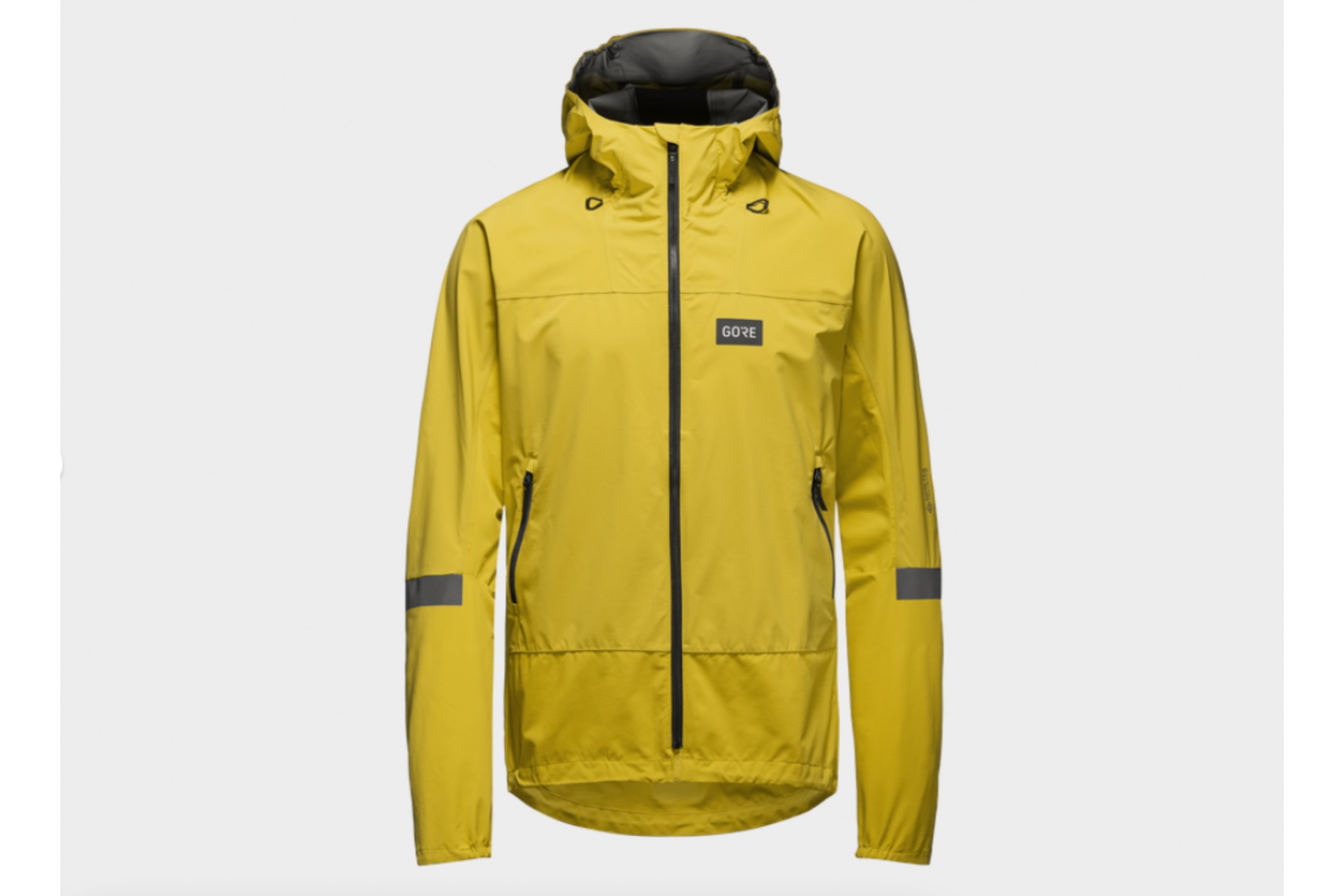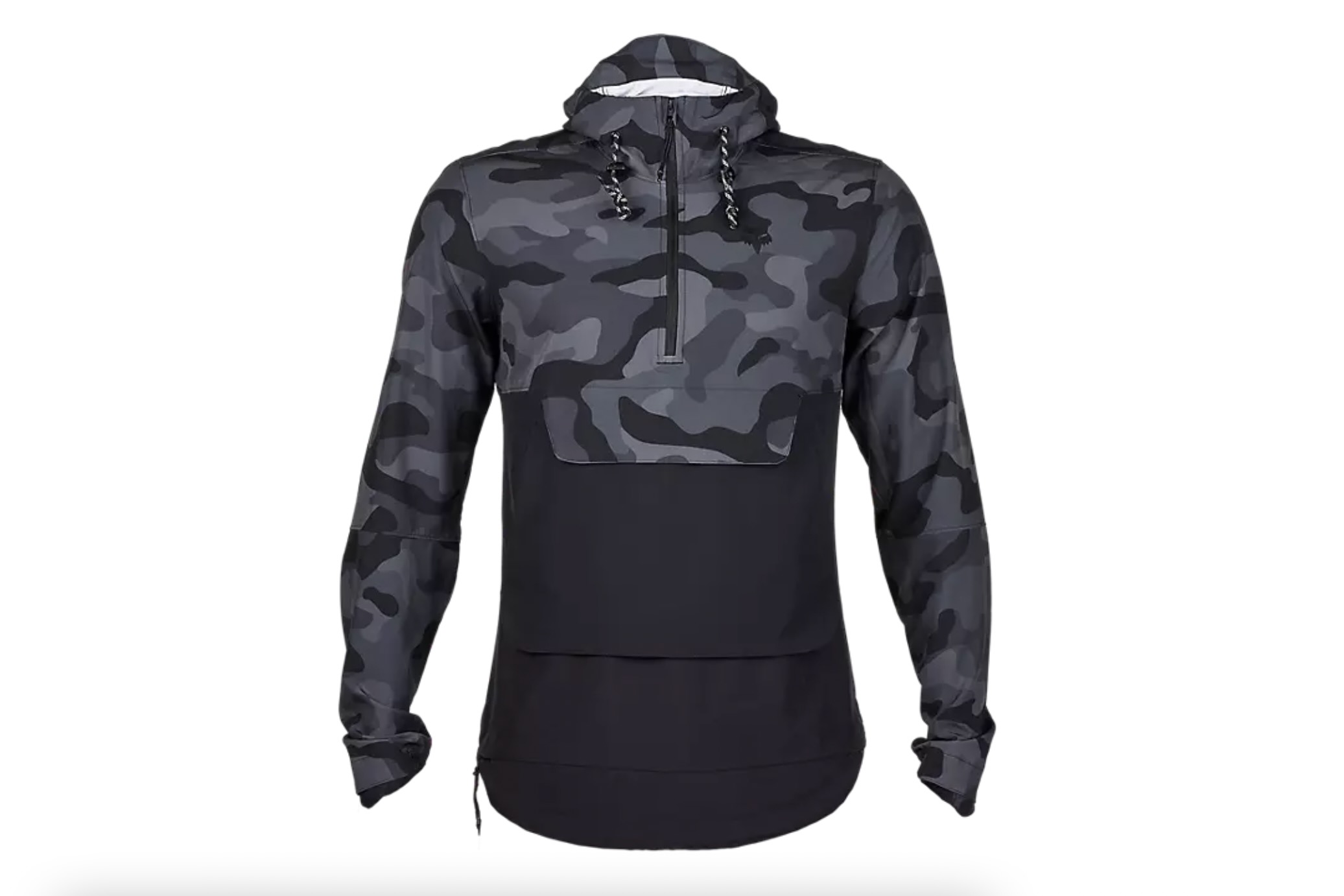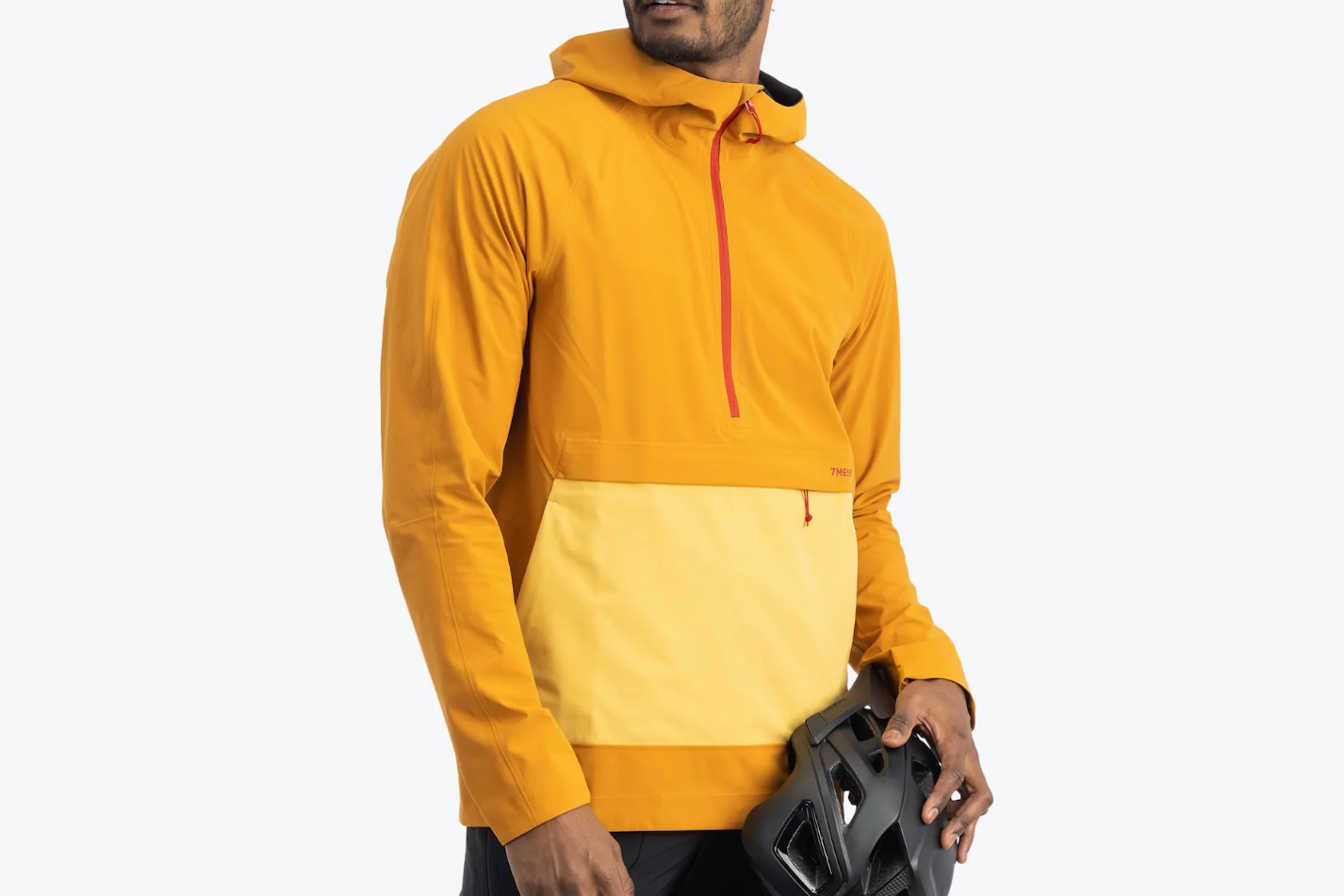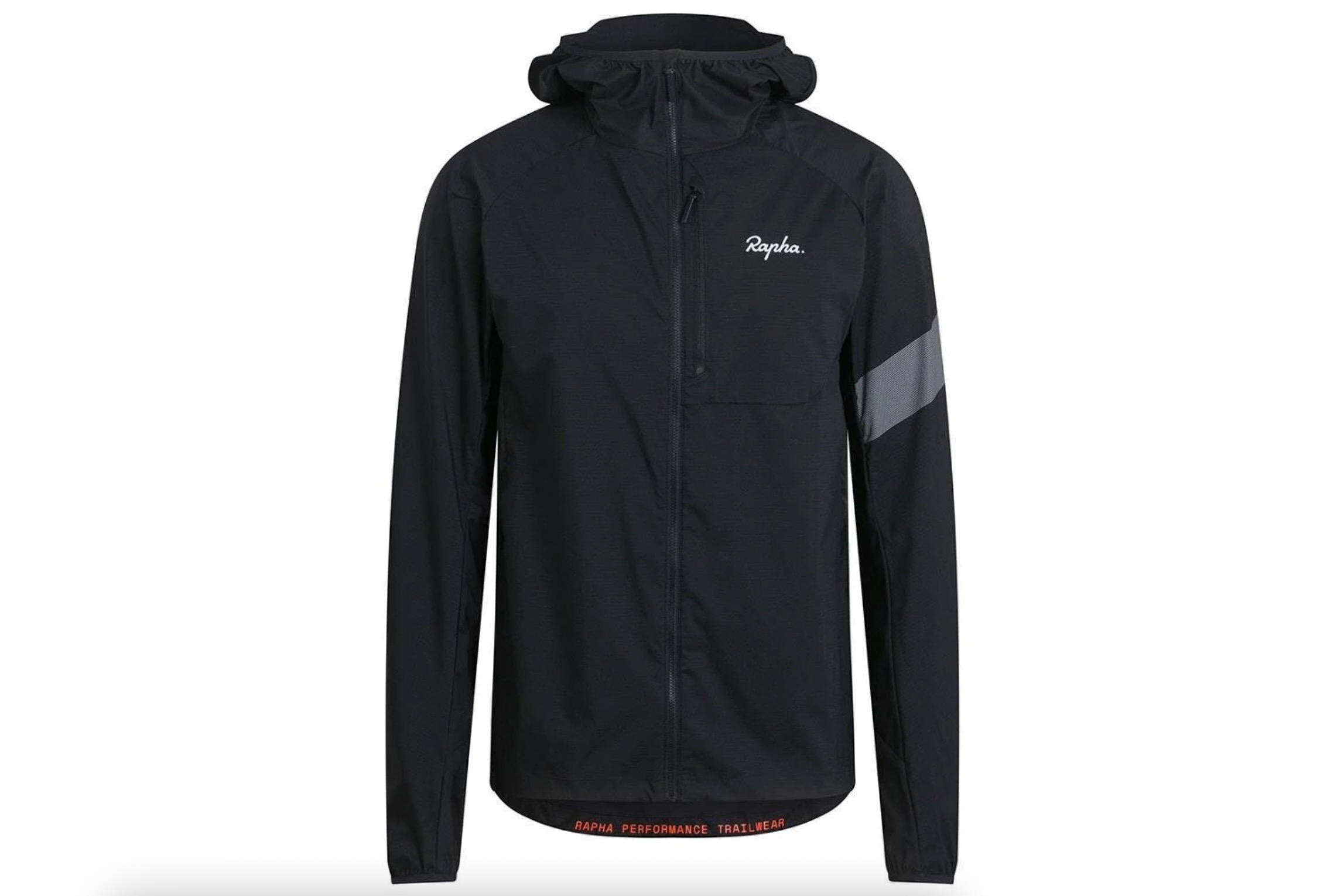When the temperatures drop or the rain starts to fall, a good mountain bike jacket can keep you comfortable out on the trail. Whether for wind, cold, rain, or all of the above, there are lots of great options on the market to keep you riding happily through the fall, winter, and spring.
For most mountain bikers, the changing seasons bring cooler temperatures and unsettled weather, along with some of the best riding conditions of the year. Having the right gear for the conditions you’ll encounter can be the difference between finishing your ride wet and cold or with a huge smile on your face. Thankfully, there are mountain bike jackets purpose-built for riding in weather ranging from mild to wild. From super waterproof rain shells, packable wind layers, breathable water-resistant jackets, and even a couple of wind block jerseys, we’ve tested 13 great models and have suggestions to keep you riding through cool temperatures, wind, and rain.
After extensive testing in a wide range of conditions, we chose our favorites and those that excel for specific reasons/conditions, followed by the best of the rest which are all solid options to consider as well. To see the specs of all the models we tested side by side, take a look at our comparison chart. If you need help deciding what to buy, our buying advice details the important things to consider when choosing the right mountain bike jacket, and our FAQ section provides answers to common questions.
The Best Mountain Bike Jackets of 2024
- Best Overall Mountain Bike Jacket: Patagonia Dirt Roamer
- Best Budget Mountain Bike Jacket: Fox Ranger 2.5L Water Jacket
- Runner-Up Best Overall Mountain Bike Jacket: Gorewear Lupra
- Best Waterproof Mountain Bike Jacket: Gorewear Endure Cycling Jacket
- Runner-Up Best Waterproof Mountain Bike Jacket: Endura Singletrack Jacket II
- Best Mountain Bike Jacket for Extreme Conditions: Endura MT500 Waterproof Jacket II
- Best Budget Wind Jacket: Fox Ranger Wind Pullover
- Best Wind Jersey: Rapha Trail Windblock Jersey
Pros
- Packable (in rear pocket)
- Recycled Materials & Fair Trade Certified factory
- Super breathable
- Good water-resistance
- Hood works great with helmets
- Great tailored fit
Cons
- Expensive
- Water-resistant, not waterproof
Fox Ranger 2.5L Water Jacket
Pros
- Great waterproofing for all but the most extreme conditions
- Adjustable hem via internal cord
- Well-placed front hand pockets
- Large, adjustable hood works well with helmets
- Recycled materials
Cons
- Fit across the shoulders was a little tight
- Inner material doesn't feel great against bare skin
Gorewear Lupra Jacket
Pros
- Versatile jacket for days that aren't too wet
- Wind-blocking front and upper arms
- Breathable back panel
- Excellent hood
- Pocket placement works well with pack straps
- Reflective elements
Cons
- Can handle light rain showers but will get wet in heavier/steady rains
Gorewear Endure Cycling Jacket
Pros
- Lightweight
- Breathes exceptionally well
- Great waterproofing
- Packable
- Rubber grip patch on well-designed hood sticks to visor and keeps hood from falling backwards
Cons
- Expensive
- Limited hood adjustability with dual friction closure
Endura Singletrack Jacket II
Pros
- Very waterproof
- Relaxed fit is easy to layer under
- Decent breathability considering the water resistance.
- Zippered armpit vents
- Ample pockets
Cons
- Sizing runs a bit big
- Tight collar with hood on over helmet
Endura MT500 Waterproof Jacket II
Pros
- Super waterproof
- Streamlined bike-specific fit
- Ample storage
- Lots of venting – pit zips and vent pockets
- Quality construction – tough, durable feel
- Feels good against the skin – for a waterproof fabric
Cons
- Expensive
- Hood is a bit bulky – annoying when not in use
- Material is kinda noisy
- Larger packed size
Fox Ranger Wind Pullover
Pros
- Cozy, comfortable, and relaxed fit
- Zippered stomach pocket is great for snacks
- Extremely stretchy
- Adjustable cord at hem
- Reasonable price
Cons
- Small hood is a stretch to fit over a helmet
Rapha Trail Windblock Jersey
Pros
- Great do it all layer for cool rides
- Breathes and breaks wind well
- Comfortable relaxed fit, but trim enough to not flap around
- Comes with 2 repair patches
Cons
- Fairly expensive for a jersey
Best of the Rest
7Mesh Cache Anorak
Pros
- Comfortable fit
- Versatile for varying conditions
- Very breathable
- Excellent stretch
- Designed to be strapped to bike
Cons
- Very expensive
- Roomier fit through torso
- Not made for soaking rains
Rapha Trail Lightweight Jacket
Pros
- Comfortable relaxed fit – not baggy but enough room to layer in
- Very lightweight
- Small packed size
- Straps to frame
- Clean styling
Cons
- DWR coating is not super water resistant – nor is it intended to be
- Hood could be slightly larger for use with helmet
- Single pocket
- Fairly expensive
Pearl Izumi Summit 3L WxB Jacket
Pros
- Very waterproof
- Adjustable hood is large and works very well over a helmet
- Stretchy material and relaxed fit is easy to layer under for very cold days
- Breathes well
- Very comfortable inner fabric
Cons
- Breathes well but a bit thicker and warmer than some competitors
- Wrist cuffs are a bit large
Pros
- Great water resistance
- Clean aesthetic
- Good breathability
- Comfortable against the skin
- Quality construction
Cons
- Expensive
- Not fully waterproof – nor is it claimed to be
- Limited pocket storage
- Wrist cuffs
Mons Royale Tarn Merino Shift Wind Jersey
Pros
- Great for cool days when a jacket is overkill
- Front panel effectively blocks wind
- Merino shift fabric is comfortable, dries quickly, resists odor
- Great color options
Cons
- Moderately expensive
- Neck opening is a little large
- Sizing runs a bit big – consider sizing down
Mountain Bike Jackets Comparison Chart
| Jacket Model | MSRP | Measured Weight | Type | Materials | Pockets |
|---|---|---|---|---|---|
| Patagonia Dirt Roamer | $249 | 219 grams (size S) | Hooded, water-resistant, packable | 100% recycled nylon | Zippered rear pocket, zippered internal pocket |
| Fox Ranger 2.5L Water Jacket | $140 | 335 grams (size S) | Hooded, waterproof | 10K/3K 2.5-layer recycled | 2 zippered hand pockets |
| Gorewear Lupra Jacket | $200 | 315 grams (size L) | Hooded, zoned windblock/water resistant | 100% polyester/polyamide, Gore-Tex Infinium front panel | 2 zippered hand pockets |
| Gorewear Endure | $250 | 280 grams (size S) | Hooded, waterproof | Gore-Tex Paclite Plus | 2 zippered hand pockets |
| Endura Singletrack Jacket II | $200 | 445 grams (size S) | Hooded, waterproof | ExoShell20 ECO 3-layer | 2 zippered hand pockets, 1 zippered chest pocket |
| Endura MT500 Waterproof | $330 | 550 grams (size L) | Hooded, waterproof | ExoShell40DR 3-layer | 2 zippered front, 1 internal, pass pocket |
| Fox Ranger Wind Pullover | $105 | 323 grams (size S) | Hooded, wind block, anorak | Windblock long-sleeve jersey | Pass-thru hand pockets, zippered front pocket |
| Rapha Trail Windblock Jersey | $135 | 178 grams (size S) | Windblock long-sleeve jersey | Merino/nylon blend, wind block front | None |
| 7Mesh Cache Anorak | $330 | 304 gram (size S) | Hooded, windproof, water-resistant | 3-layer Airmap body, 2-layer Airmap back | Zippered kangaroo hand pockets, zippered stomach pouch |
| Rapha Trail Lightweight Jacket | $180 | 160 grams (size S) | Windblock long-sleeve jersey | 100% nylon ripstop | 1 zippered chest pocket |
| Pearl Izumi Summit 3L WxB | $185 | 356 grams (size S) | Hooded, waterproof | 10K/10K 3-layer waterproof | 2 zippered hand pockets |
| Rapha Trail Gore-Tex Infinium | $375 | 280 grams (size S) | Hooded, windproof, water-resistant | Nylon/polyester/elastane blend w/ Gore-Tex Infinium | 1 zippered external chest, 1 zippered internal chest |
| Mons Royale Tarn Wind Jersey | $140 | 219 grams (size M) | Windblock long sleeve jersey | Merino blend with Pertex front panel | None |
Why Should You Trust Bikerumor?
The team at Bikerumor consists of cycling-obsessed individuals who are scattered around North America and Europe where most of us encounter all four seasons. And, we don’t stop riding because the temperatures drop and the weather changes. Instead, we gear up and get out there. Riding bikes is a big part of the job, after all, but keeping the wheels spinning through fall winter and spring requires the proper gear to keep it enjoyable, and we have all learned the importance of having a good mountain bike jacket to keep the cold, wind, and water from ruining our fun. We’re also lucky to get to test lots of the best new gear, so we’ve got an inside track on the best mountain bike jackets on the market. And, if you ride on the road, we’ve tested the best cycling jackets for the drop bar crowd too.
For our mountain bike jackets buyer’s guide, Bikerumor contributor, Paul Clauss tested the majority of the models in this review. Paul lives in northern Vermont where riding in the fall and spring means dealing with cool to frigid temperatures, frequent rain storms, and rain-soaked trail conditions, and having a quality mountain bike jacket or two is critical to staying warm and/or dry. A mechanical engineer by trade, Paul is also quite adept at analyzing designs and constructions and putting products through their paces to determine their performance differences. Paul has spent lots of time testing gear this year, including the mountain bike flat pedal shoes and the flat pedals to go with them as well as the best mountain bike hip packs. In addition to Paul’s testing, we also drew from Bikerumor’s editorial staff and included several products that were tested by various members of our team. Rest assured, every product included here has been thoroughly tested for at least several weeks, and in some cases many months or more.
How We Tested Mountain Bike Jackets
We strive to provide our readers with trustworthy reviews to help inform your purchase decisions, so every product in this buyer’s guide has been tested in the real world to see how it performs. To test these mountain bike jackets, we weighed them for consistency and comparison to the manufacturer’s specs and packed them into their smallest packed size to see how portable they were. We closely examined the materials, constructions, seams, and zippers to assess the quality of craftsmanship and attention to detail. The fit of each model was examined both at home and, most importantly, out on the trail to get a sense of how well they cover the body, move with you while you ride, and function on the bike. Features like hoods, pockets, and adjustments were analyzed to assess their functionality and usefulness. And, each model was used for extended periods in the temperature and weather conditions for which it was intended, including cold, windy fall days, crisp, frosty mornings, rainstorms, rain showers, and even a few hose tests.

Buying Advice: How to Choose a Mountain Bike Jacket
There are numerous factors to consider when choosing the right jacket for mountain biking. One of the most important is the intended use or the conditions you’ll be encountering on your fall, winter, and spring rides. This will help you narrow down your search to a specific type of jacket that will be best suited to your needs whether that’s wind, water-resistance, or both. After that, other factors like fit, materials, packability, breathability, pockets, features, and price are other considerations depending on your specific needs and budget.
Intended Use
The type of temperature and weather conditions you intend to be riding in will be the most important factor in deciding what type of jacket you need. The jackets we tested range from lightweight wind shells to burly waterproof rain jackets and models that intend to strike a balance between those extremes.

Wind
If you generally try to avoid riding in the rain and simply need something to protect you from the chilling bite of the wind, a wind jacket, or possibly a wind jersey may be the best bet. Wind-resistant jackets are a great option to have for cold mornings or chilly spring or fall days when it is generally dry. They are typically lightweight and made from thinner breathable materials, and they are often quite packable. While they often feature a durable water-repellant (DWR) coating and can be a good option in very light precipitation and are effective for handling splashes from puddles or mud, they are usually not intended to be fully waterproof.

Rain
If you purposefully ride when it’s raining or often find yourself getting caught out in rainstorms, then a waterproof (or highly water-resistant) jacket is probably the right call. Waterproof jackets typically incorporate waterproof membranes into their constructions, which, along with taped seams, intend to completely block all water from making its way inside. These materials are almost always treated with a DWR coating to the outside to promote the water beading running off as opposed to soaking into the outermost layer of the fabric. While modern materials allow truly waterproof jackets to be fairly breathable, they are generally a bit warmer and less breathable than thinner windbreaker options. A good waterproof shell should keep you dry in the most extreme wet weather conditions you are likely to encounter on a ride and is a necessity in some areas like the damp Northeast and Pacific Northwest of the US, or the UK.

Wind and Light Rain
For many riders, a simple wind layer may not be quite enough and a full-on rain jacket may be overkill, so thankfully there are options that fall into the middle of the spectrum. These highly versatile jackets provide great wind protection and a high level of water resistance and are capable of fending off light rains, intermittent showers, and tire spray from rain-soaked trails. With a DWR coating and water-resistant materials, these jackets are not fully waterproof, but they will still typically keep you dry in most conditions short of heavy rain, which most of us try to avoid anyway. They also tend to dry very quickly, making them a great option for riding on those unsettled days when the weather just can’t seem to make up its mind.
Cold
If you ride when it’s really cold, then you definitely want to block the wind and you probably also want some insulation. Both wind and waterproof jackets will add a layer of protection from the wind that takes the edge off the chill, and smart layering underneath is one of the best ways to gear up for a winter ride, similar to going skiing. In general, the thicker materials used on waterproof jackets will provide a touch more warmth than light wind layers. When it’s really, really cold, many people will opt for insulated jackets or mid-layers to help maintain body heat. While we didn’t test any insulated jackets, there are lots of great options on the market.
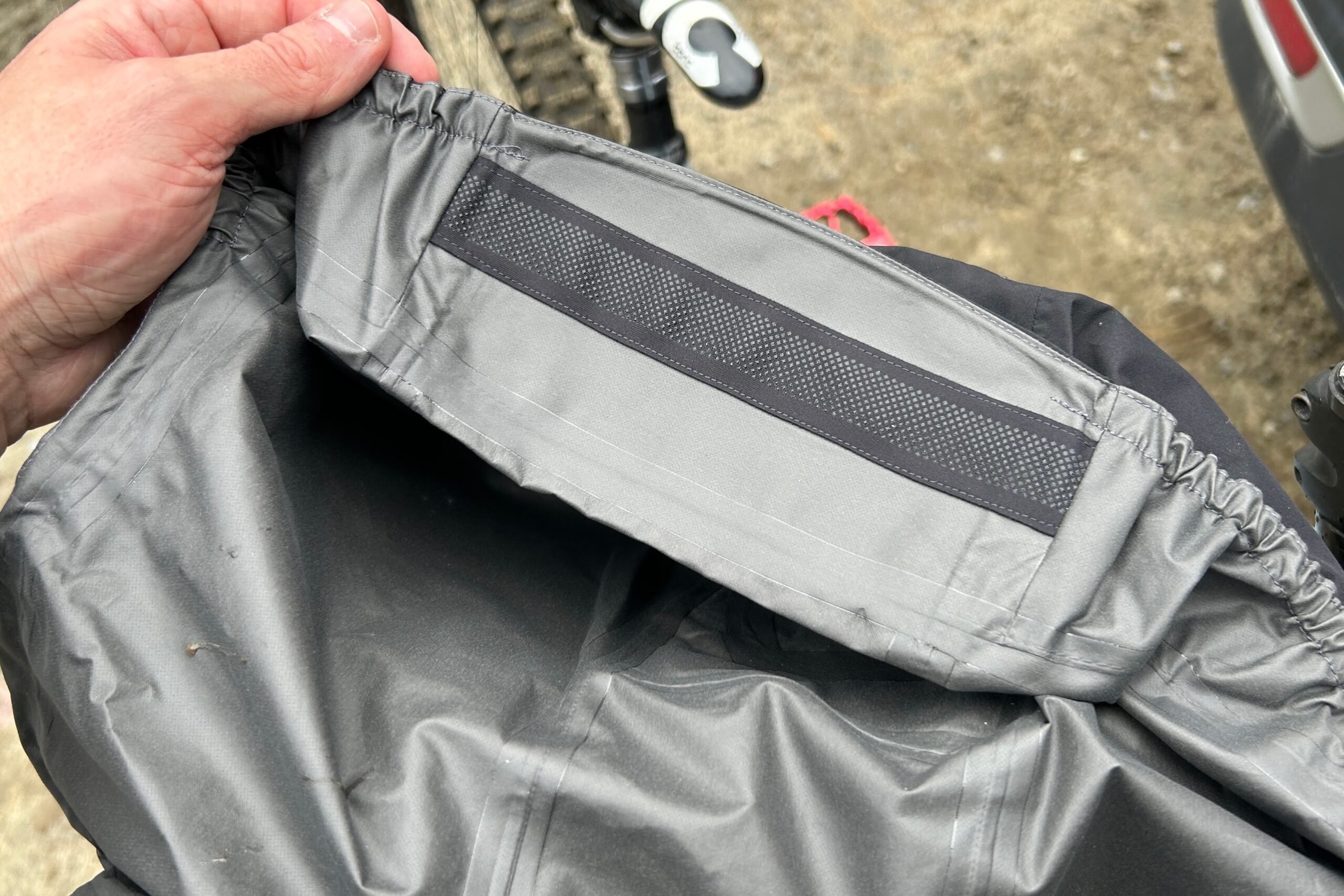
Materials
Mountain bike jackets are made from a variety of materials depending on the intended use. These range from superlight wind-blocking fabrics to heavy-duty fully waterproof materials. Wind jackets have the easiest job and are generally made from lightweight, stretch nylon or polyester that only aims to block the wind and/or splashes from puddles. These materials are often treated with a DWR to help shed light amounts of water. Examples of wind jackets we tested are the Rapha Trail Lightweight and the Fox Ranger Wind Pullover.
Waterproof jackets are typically made from more advanced fabrics that include waterproof membranes like the Gore-Tex PACLITE used in the Gorewear Endure, or the ExoShell 40DR used in the Endura MT500 Waterproof Jacket II, as examples. Waterproof fabrics vary in weight, thickness, breathability, and even water resistance, and while they all get the job done, they are not created equal. Jackets made from waterproof materials typically have a couple of numbers associated with them, like 10K/10K, that provide ratings for waterproofness and breathability, respectively. These numbers are derived by lab tests to determine where they land on the rating scale. The higher the numbers, the more waterproof and breathable a material is, and vice versa. Additionally, these materials are almost always treated with a DWR to shed water at the surface.
In between the lighter wind materials and the completely waterproof options are those that are wind-blocking and highly water-resistant. These are essentially a hybrid of the two. While not completely waterproof, these jackets are typically a bit lighter, more easily packable, and more breathable than rain jackets while still providing enough water resistance for most situations. Gore-Tex Infinium is a commonly used membrane found in the Rapha Trail Gore-Tex Infinium Jacket and parts of the Gorewear Lupra Jacket that blocks wind and repels water well in most situations short of proper downpours. Likewise, the Patagonia Dirt Roamer Jacket works similarly with a great DWR that sheds water very effectively, but only up to a point.

Durable Water-Repellant (DWR)
DWR treatments/coating/finishes have been around for many years and they are a treatment applied to the outside of most jackets that causes water to bead up and run off of the material as opposed to soaking in. These treatments work very effectively when garments are new, however, they do break down over time, use, and exposure to the sun, water, mud, dirt, etc. When this happens, you’ll notice the outermost layer of the material may begin to “wet out” or absorb some of the water on the surface. With a truly waterproof membrane underneath, you’ll still stay dry, but this can have an adverse effect on the material’s breathability. Often, simply washing your jacket can help to revitalize the DWR, but eventually, it will probably need to be reapplied. Nikwax makes a number of wash-in DWR replenishment products for use at home that work quite well and there are technical equipment cleaners that may be able to do it for you. Before doing any at-home DWR treatments, however, we recommend checking with the manufacturer for specific recommendations.
When DWR treatments first came out, they were mostly made from “forever chemicals” that had toxic by-products that persist in the environment and are “possibly carcinogenic” according to the International Agency for Research on Cancer. These chemicals, often referred to as PFAs and/or PFCs were even banned in many countries. Brands have been seeking alternatives, and these days most companies are claiming to use PFC-free or non-toxic DWR treatments on their garments.

Fit
Like all outerwear, a jacket should fit well and allow a full range of motion on and off the bike. Most of the jackets we tested have mountain bike specific fits optimized for riding – a slim midsection, articulated arms, gusseted underarms, an extended rear waist hem to keep your hindquarters dry, and a large hood for use with helmets. The fits are tailored but relaxed – loose enough to be comfortable on and off the bike and layer underneath, but streamlined enough to not flap around excessively, fall over your hands, or catch on your seat while riding.
For mountain biking, we’ve found that it’s important to get the right size, as a jacket that is too small can restrict movement or be uncomfortable and one that is too large might flap excessively in the wind, snag on your saddle, or have sleeves that extend down too far over your hands. In general, going with the same size you usually buy for jerseys or casual wear will probably work well, but not always. When in doubt, check your measurements and reference a brand’s size chart. Some brands show pictures of models along with their dimensions and the size they are wearing for reference. And, if possible, trying something on before you buy is always the best way to ensure you get something that fits.
We have noticed in the past few years that many brands’ sizing has been trending a little larger than it used to. For example, one of our testers is a 6-foot-tall male who has been a size Large top for as long as he can remember. Recently, he has been easily and comfortably fitting into size Medium jerseys and jackets, despite the fact that his body size hasn’t changed. That said, it’s worth double-checking size charts before you buy, or buying something that can easily be returned or exchanged if it doesn’t fit quite right.
Features
Like the type of jacket, the features you need or want may vary depending on the intended use. Most wind and rain jackets feature hoods, several pockets, ventilation, and a variety of adjustments to dial them into your needs or the conditions.

Hood
All of the jackets we tested have one thing in common, a hood. Not all hoods are created equal, of course, and some are executed far better than others. Things we look for in a hood on a mountain bike jacket are the ability to fit over a helmet comfortably and securely, adjustability, and for it to move with your head without constricting or getting into the peripheral vision. Of course, it’s also nice when they tuck away neatly and/or sit comfortably behind the head when not in use.
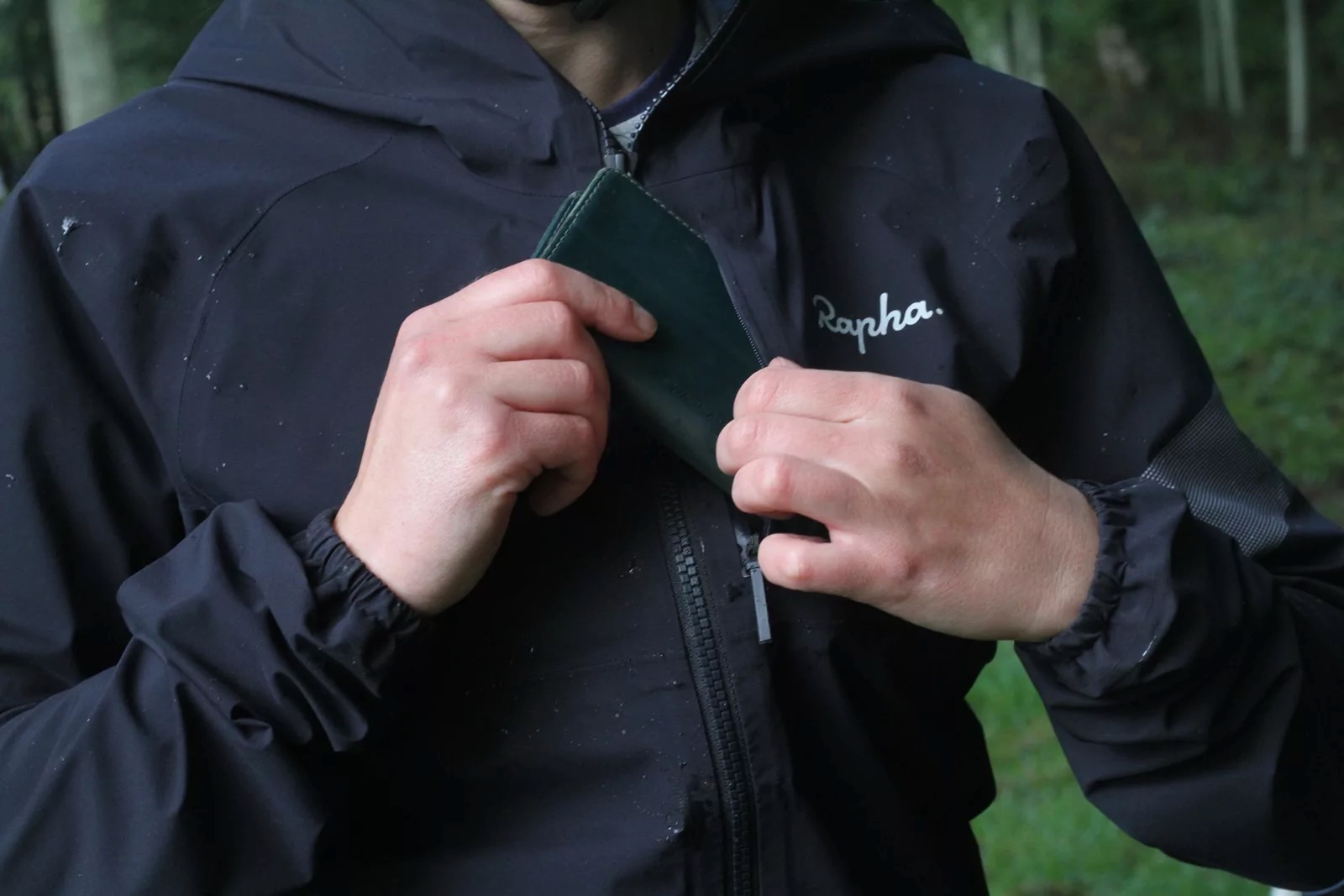
Pockets
Depending on what you like to carry with you when you ride, pockets may or may not be a big consideration. The jackets we tested vary considerably in the number, placement, and storage capacity of their pockets. If you’re a minimalist or you carry most of your essentials in shorts/pants pockets, cargo bib pockets, in-frame storage, or a pack of some kind, then a jacket with a single pocket might be just fine for your needs. If you want to carry a phone, wallet, keys, snacks, and tools in your jacket, then you’ll probably want to look for something with several pockets and ample storage space. The Endura MT500 Waterproof Jacket II has the most pockets and storage capacity of all the models we tested, plus they are well executed and designed to stay out of the way of pack straps.

Wrist Cuffs
Wrist cuff designs vary by brand and intended use of the jacket. Most mountain bike jackets have extended cuffs that hang a little farther than normal so they don’t ride up when you’re leaning forward and to cover the back of the wrist/bottom of gloves. Some have elastic to keep them semi-tightened around the wrist while others are adjustable through velcro straps. What works best for you will depend on the conditions you’re riding in and how you want them to interface with your gloves (if you wear them). If, for example, you’re riding in extremely wet or cold conditions, you may want to be able to tighten the wrist cuff around your mountain bike gloves to seal out the water or frigid air.
Drawcord Hem
The majority of mountain bike jackets have a drawcord hem that can be used to cinch the bottom of the jacket tight around the body. While many riders may never feel the need to use such an adjustment, it is a nice feature to have on particularly cold or wet days to prevent cold air or water/mud from entering up through the bottom of the jacket.

Ventilation
Many jackets rely on the breathability of the materials to allow heat and moisture to escape. Often, especially in the case of rain-specific jackets, that isn’t enough, so some have armpit and/or pocket vents built into their designs. Vents can be a great feature to evacuate body-generated heat if/when the material can’t do it for you. Of course, unzipping the front zipper is also an excellent way to get some air flowing inside the jacket. Both the Endura Singletrack II and the MT500 Waterproof II feature ventilation. Adding vents to a jacket does have the adverse effect of adding weight and decreasing packability.
Breathability
When we ride we generate body heat and perspire, even when it’s cold and/or rainy. This is especially true when riding with a jacket as most are not nearly as breathable as riding without one. And, when riding in the cold, being wet with sweat can make you feel even colder when you are in the wind or start riding downhill. Regulating temperature is tricky, and something that the user needs to stay on top of because even the most breathable waterproof fabric still ends up trapping user-generated heat and moisture. Some fabrics perform much better in this regard, effectively allowing your heat and moisture to escape while keeping chilling wind and water from getting in, while others are a bit stuffier and feel wet on the inside. The Patagonia Dirt Roamer Jacket is impressively breathable and helps to maintain a consistent comfort level inside the jacket, making it easier to leave on all the time without overheating or getting drenched in sweat.

Packability
For those among us who like to bring a jacket on a ride in the off chance it might rain or because you know you’ll be taking it off the climbs and putting it back on for the descents, packability, and weight, is an important consideration. Our storage space, whether it’s in a mountain bike hip pack, backpack, cargo bib pocket, or in-frame storage, is relatively finite, so being able to pack your jacket down to a compact size that fits in that space is essential. For those carrying a jacket, weight is also a concern, and typically, the lighter the better.
When it comes to packability, the lighter wind jackets typically take the cake. For example, the Rapha Trail Lightweight jacket weighs just 160 grams (size S) and packs into the chest pocket to a tiny size. Additionally, it comes with a strap that can be used to stash it on your frame when not in use. Likewise, the Patagonia Dirt Roamer Jacket weighs just 219 grams (size S), stuffs into its own pocket, and is approximately the size of a 20-ounce water bottle.
In contrast, the thicker materials used in most waterproof jackets make them a bit heavier and they aren’t able to pack down quite as small. The exception to this rule is the Gorewear Endure which is made with Gore-Tex PACLITE, weighs just 280 grams (size S), and is about as packable as fully waterproof jackets get. On the flip side of that coin is the Endura MT500 Waterproof Jacket II which weighs 550 grams (size M) and would be nearly impossible to fit into a fanny pack if you had to take it off.

Wind Jerseys
Along with the ten jackets we tested, we included two wind-blocking jerseys as alternatives for cool-weather riding. While they are obviously not jackets, a wind-blocking long-sleeve jersey can be the perfect layer to wear on cool days when all you really need is to take the bite out of the wind to stay comfortable. The two options we tested, the Rapha Trail Windblock Jersey and the Mons Royale Tarn Merino Shift Wind Jersey, both feature merino wool blend fabrics that comprise the main body, covered by a wind-blocking nylon front panel to keep the wind off your torso. We found both of these jerseys to be excellent for cool temperatures where you generate some body heat on the climbs but might catch a chill on the decents. They proved to be exceptionally versatile pieces that get a lot of use in the fall and spring.

Value
There is a large variation in price between the jacket models we tested, and like anything else in the sport of mountain biking, they can be quite expensive. Spending more on a jacket typically gets you higher quality materials, construction, or something unique that excels in a specific way like waterproofness or packability (maybe both). Other times it gets you those things plus a brand name. While we certainly love looking fancy in expensive gear, we also appreciate a good value, and we know a lot of other people do too. So, sure, you can spend $330 to get the bombproof Endura MT500 Waterproof Jacket II, or you can save over a hundred bucks and get the Endura Singletrack II which performs nearly on par with its more expensive sibling. Yes, the Singletrack II isn’t technically as waterproof as the MT500, but it’s got to be so miserable outside to matter that you probably shouldn’t be out there anyway. Similarly, the Fox Ranger 2.5L Water Jacket costs even less and gets the job done while looking pretty snappy to boot. And, if you’re only looking for a wind jacket, the Fox Ranger Wind Pullover is the least expensive option we tested, yet it performs well while having a casual style that doesn’t pigeonhole it as strictly a riding piece.
Frequently Asked Questions About Mountain Bike Jackets
While you definitely can and many people do ride mountain bikes in jackets not specifically designed for mountain biking, we prefer riding in jackets made for the task for several reasons. Mountain bike jackets have bike-specific designs, cuts, and features that are purpose-built for riding a bike. Things like articulated arms and gusseted underarms are made for being in the riding position and they help prevent the jacket from riding up when you’re leaning forward or moving around on the bike. Many jackets have tailored fits that are streamlined to avoid excessive bagginess, along with having a longer rear hem that drops down to cover more of your backside and protect it from tire spray. Hoods that fit over helmets are another important feature, as well as pockets designed to carry stuff while you ride and stay out of the way of pack straps. Packability is another consideration as many mountain bike jackets are designed to pack down small to make them easy to carry when not in use.
What kind of weather will you be encountering on your rides? Considering the conditions you expect to encounter in the fall, winter, and spring will help you zero in on the type of jacket you need. If you never ride in the rain, then a wind jacket should probably do the trick. If you always ride in the rain, then you’re going to need a waterproof jacket. For many people, having multiple jackets might be necessary to cover the spectrum of riding conditions they will encounter, while others can go for a versatile all-arounder that does the trick pretty much all of the time.
Waterproof jackets are often rated on a waterproof/breathability scale that is represented in _K/_K. Though not all the jackets we tested use this measurement, it is relatively standard and can be used to estimate the water resistance and breathability of a material. The first number refers to water column pressure – representing the water in pressure that can be exerted on the fabric before it soaks through. A garment with a 10K rating can withstand a water column pressure of 10,000mm before water permeates the material. The higher the number, the more waterproof the material is.
The second number in the rating refers to breathability, indicating the amount of moisture in grams that can pass through a square meter of fabric in a 24-hour period, estimating how easily moisture generated by your body escapes through the material. Higher breathability ratings mean better moisture management and should feel less clammy or sticky when worn in warmer or more humid conditions.
It really depends on the jacket. Definitely take a look at the care instructions on the tag or on the brand’s website to make sure you do it correctly. Simple wind jackets can often just get machine-washed and hung to dry and they are basically good as new. Waterproof materials and those that are treated with DWR often need to be washed with a bit more care, and the DWR treatments do occasionally need to be reapplied. Wash-in DWR treatments, such as Nikwax, can work pretty well, but it is always best to check the manufacturer’s recommendations for reapplication.




